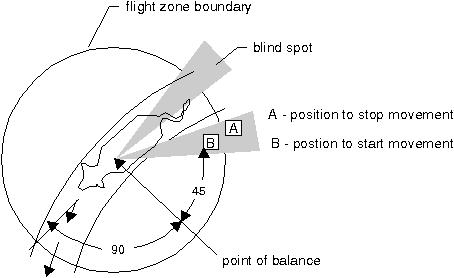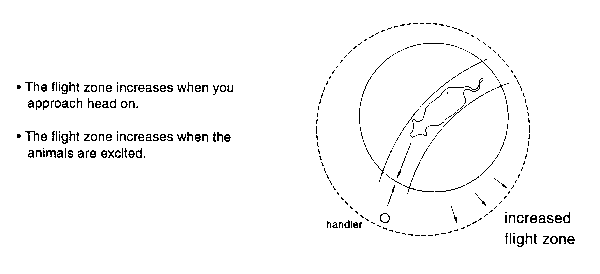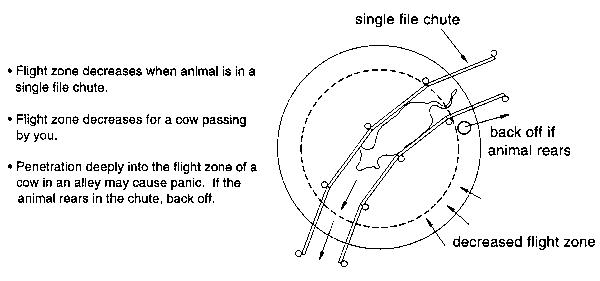| | Understanding the flight zone
Cattle Behaviour
Effects of stress on cattle
- Reduced weight gain
- Poor reproductive performance
- Reduced ability to fight disease
Temple Grandin says "Handling practices can be less stressful to the animals and safer for the handler if one understands the behavioural characteristics of livestock."
Genetics
Breed differences mean some cattle are more excitable. Recognize this while handling cattle.
Individual differences
Each animal is an individual and has a different reaction to stress.
Past experience
Animals have long memories. If they have been handled roughly in the past, they will be more stressed and difficult to handle in the future. Choice is a factor in stress - feedlot cattle who will freely investigate a coat hanging on a fence will balk when forced to walk past the same coat hanging on a chute or flapping in the breeze.
Familiarity with the environment
New pens and facilities are stressful. Let the cattle get used to the corrals. Cattle also show signs of stress when they are isolated. A single animal left alone in a crowding pen or working chute will try to rejoin its herdmates and may charge the handler.
Reproduction
Rough handling during artificial insemination (AI) can raise body temperatures and lower conception rates. High body temperature at the time of insemination increases the risk of early embryonic death. Excitement before insemination depresses secretion of hormones that stimulate contractions of the reproductive tract that move sperm to the site of ovum fertilization. Use a dark box to hold cows. You can hold the wildest cow with minimum distress.
Disease
There is evidence that stress due to rough handling can affect cattle's immune response - they are more susceptible to disease.
Vision
Cattle have excellent wide angle vision, in excess of 300 degrees, due to the position of their eyes. Cattle can see behind themselves without turning their heads. Ruminants do have depth perception, but they have difficulty perceiving depth at ground level while they are moving with their heads raised. To see depth at the ground, the cow has to lower its head, perhaps explaining why cattle balk at shadows or distractions at ground level.
Understanding the Flight Zone
The flight zone is the animal's personal space. If you move inside the flight zone, the animal will move away. When you back off, the animal will stop moving. The size of the flight zone depends on wildness or tameness of the cattle, angle of handler approach and state of excitement of the cattle. Work at the edge of the flight zone at an angle of 45 to 60 degrees behind an animal's shoulder. The cattle will circle away from you. The flight zone radius may be 5 to 25 ft. for feedlot cattle and 300 ft. for range cattle. If you are behind the point of balance, the animal retreats.
A technique that works well with cattle that are moving is not to approach cattle directly, but to work close to the point of balance, moving back and forth on a line parallel to the direction the animal is travelling.

Figure 1. The flight zone

Figure 2. Increased flight zone

Figure 3. Decreased flight zone
Curved chutes
Curved working chutes prevent the animal from seeing the truck, squeeze chute and people until it is almost in the truck or squeeze. A curved chute takes advantage of the animal's natural circling behaviour. As you enter a pen the animals will form a circle around you and face you. As you move through the pen, they will circle around you.
A catwalk along the inside of the chute will force the handler to stand in the best position for moving the animal and will let the animal circle away from the handler. Never have a catwalk overhead.
Herd instinct
Cattle follow the leader. They are motivated to maintain visual contact with each other. Each animal should be able to see others ahead of it. Make single file chutes at least 20 ft. long, 30 to 50 ft. for larger facilities. Don't force an animal in a single file chute unless it has a place to go. If the cow balks, it will continue balking.
Blocking gates in a chute need to be "see through" so cattle can see the animals ahead. If a cow sees a dead-end it will balk.
Handle small groups in crowding pens, 8 to 10, instead of 20. The cattle need room to turn. Use the cattle following behaviour to fill up the chute. Wait until the single file chute to the squeeze is almost empty before refilling. The crowd gate is used to follow the cattle, not to shove up against them. If a lone animal refuses to move, release it and bring it back with another group.
An animal left alone in a crowding pen will become agitated and may attempt to jump the fence to rejoin its herdmates.
Response to light
Uniform lighting is important. Cattle avoid shadows. Striped shadows and contrasting patterns will cause balking.
Cattle in the dark will move towards the light. If you are loading at night, use frosted light to shine into the truck. Avoid glare in their faces.
Livestock tend to balk if they have to look into the sun. Face your loading chute and squeeze north-south for summer handling.
Cattle may refuse to enter a dark, indoor working chute from a bright, outside crowding pen. Extend the chute outside the building or cover the crowding area.
Response to movement
Cattle balk at moving or flapping objects. Use solid sides for the construction of crowding pens, single file chutes and loading chutes. Stand back from the headgate so that the cattle cannot see you.
Prepared by: Engineering Services
Source: Beef Herd Management Reference Binder and Study Guide 807-1 |
|